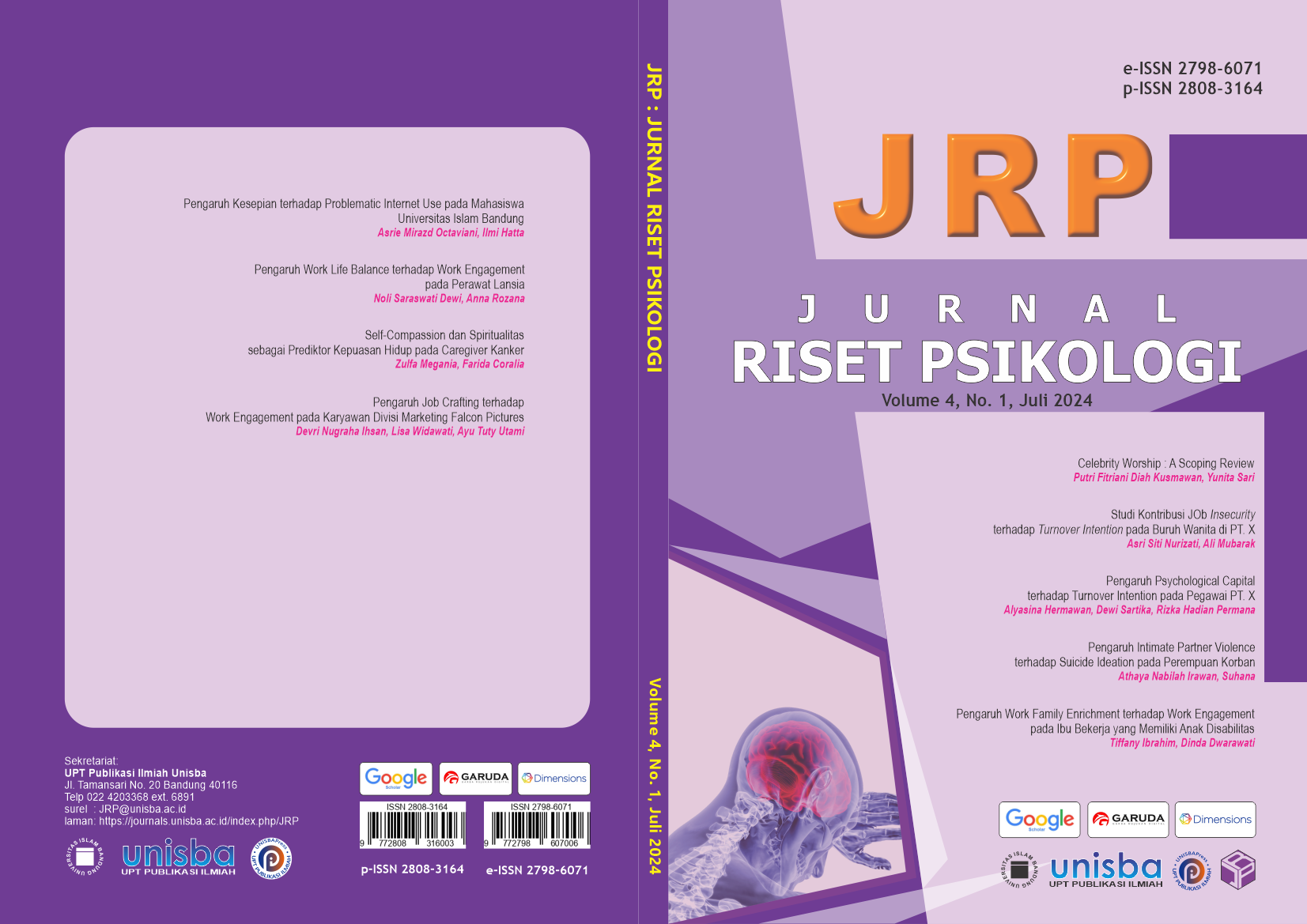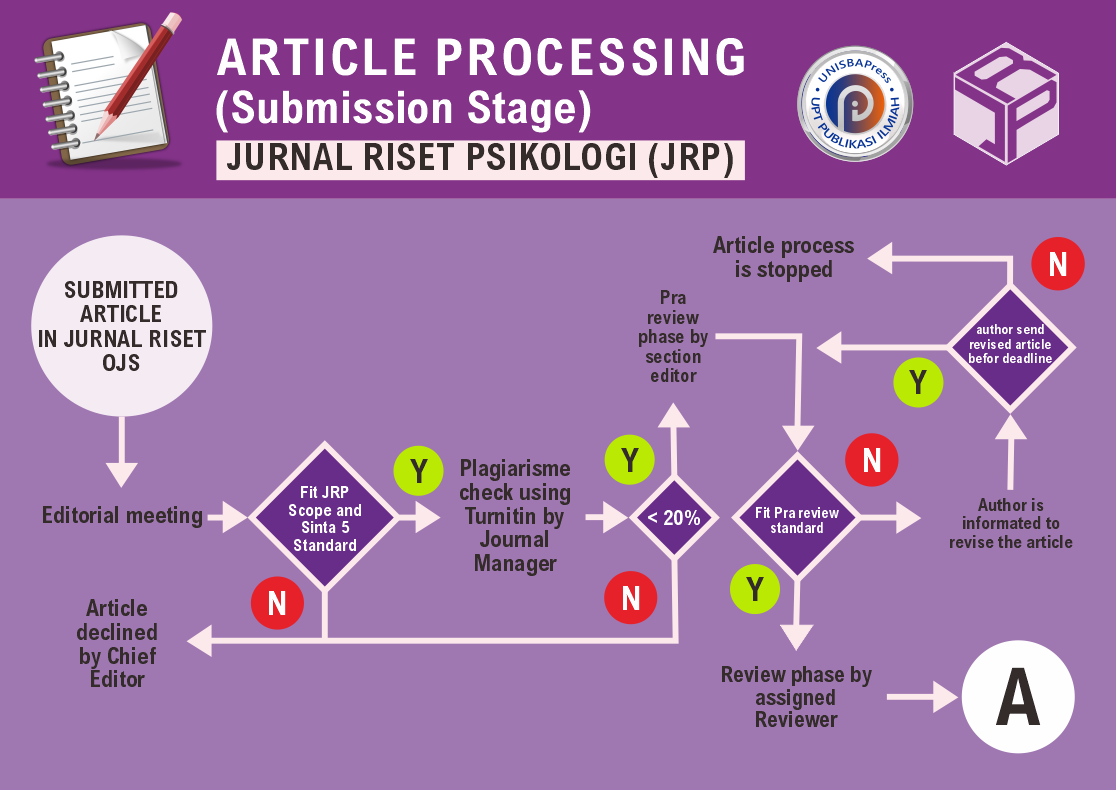Pengaruh Work Life Balance terhadap Work Engagement pada Perawat Lansia
DOI:
https://doi.org/10.29313/jrp.v4i1.3887Keywords:
Work Life Balance, Work Engagement, Elderly CaregiverAbstract
Abstract. Work engagement is a positive state of mind and fulfillment related to work that has the characteristics of vigor, dedication, and absorption (Shaufeli et al., 2002). One of the factors that can enhance work engagement is work-life balance. Work-life balance is the effort to balance two or more roles that one engages in (Fisher, 2009). This study aims to determine the influence of work-life balance on work engagement among elderly caregivers at Nursing Homes in the city of Bandung. The measurement tools used are the Work-Life Balance Scale (WLBS), referring to Fisher et al.'s theory (2009), adapted by Gunawan et al. (2019), and the Utrecht Work Engagement Scale-9 (UWES-9), referring to Schaufeli et al.'s theory (2002), adapted by Kristiana et al. (2018). The sampling technique used is saturation sampling with a total of 37 respondents. The method used in this study is a quantitative causal method, employing multiple linear regression analysis techniques. The results of this study indicate that, simultaneously, work-life balance has a significant effect on work engagement, accounting for 60.4%. Meanwhile, on a partial basis, the dimension of Personal Life Interference with Work (PLIW) contributes to an effect of 34.8%, and the dimension of Personal Life Enhancement of Work (PLEW) contributes to an effect of 18.4%.
Abstrak. Work Engagement merupakan suatu keadaan pikiran yang positif serta pemenuhan yang berkaitan dengan pekerjaan yang memiliki karakteristik vigor, dedication, dan absorption (Shaufeli et al., 2002). Salah satu faktor yang dapat meningkatkan work engagement yaitu work life balance. Work life balance adalah upaya menyeimbangkan dua peran atau lebih yang dijalani (Fisher, 2009). Penelitian ini bertujuan untuk mengetahui pengaruh work life balance terhadap work engagement pada perawat lansia di Panti Jompo Kota Bandung. Alat ukur yang digunakan yaitu Work Life Balance Scale (WLBS) yang mengacu pada teori Fisher et al., (2009) yang diadaptasi oleh Gunawan et al., (2019) dan Utrecht Work Engagement Scale-9 (UWES-9) yang mengacu pada teori Schaufeli et al., (2002) yang diadaptasi oleh Kristiana et al., (2018). Teknik sampling yang digunakan adalah sampling jenuh dengan responden sebanyak 37 orang. Metode yang digunakan dalam penelitian ini yaitu metode kuantitatif kausalitas dengan menggunakan teknik analisis regresi linear berganda. Hasil penelitian ini menunjukkan bahwa, secara simultan work life balance berpengaruh signifikan terhadap work engagement sebesar 60.4%. Sedangkan secara parsial yang memberikan pengaruh yaitu dimensi Personal Life Interference with Work (PLIW) sebesar 34.8% dan dimensi Personal Life Enhancement of Work (PLEW) sebesar 18.4%.
References
S. A. Prahara, “Budaya Organisasi dengan Work Engagement pada Karyawan,” Jurnal RAP (Riset Aktual Psikologi Universitas Negeri Padang), vol. 10, no. 2, p. 232, Jan. 2020, doi: 10.24036/rapun.v10i2.106977.
D. N. Muhadi and U. A. Izzati, “Hubungan Antara Psychological Well-Being Dengan Work Engagement Pada Perawat Instalasi Rawat Inap di Rumah Sakit ‘X,’” Character : Jurnal Penelitian Psikologi, vol. 7, no. 3, Jun. 2020.
N. Ghaniyyaturrahmah and T. D. Djamhoer, “Pengaruh Perceived Organizational Support terhadap Work Engagement pada Perawat RSUD Majalengka,” Jurnal Riset Psikologi, vol. 3, no. 2, pp. 93–100, Dec. 2023, doi: 10.29313/jrp.v3i2.2752.
W. B. Schaufeli, M. Salanova, V. Gonza´lez-Roma´, and A. B. Bakker, “The Measurement Of Engagement And Burnout: A Two Sample Confirmatory Factor Analytic Approach.,” J Happiness Stud, pp. 71–92, 2002.
Gallup, “State of the global workplace 2021 report,” Gallup Press.
D. P. Larasati, N. Hasanati, and - Istiqomah, “The Effects of Work-Life Balance towards Employee Engagement in Millennial Generation,” in Proceedings of the 4th ASEAN Conference on Psychology, Counselling, and Humanities (ACPCH 2018), Paris, France: Atlantis Press, 2019. doi: 10.2991/acpch-18.2019.93.
L. Ramadhanty and A. Rozana, “Pengaruh Job Insecurity terhadap Work Engagement pada Tenaga Kependidikan Honorer di Sekolah,” Bandung Conference Series: Psychology Science, vol. 3, no. 1, Jan. 2023, doi: 10.29313/bcsps.v3i1.5147.
P. Lestari, Q. Violinda, and H. C. Goeltom, “Pengaruh Work Life Balance dan Disiplin Kerja terhadap Kinerja Guru SMA di Kota Semarang pada Saat Pandemi Covid-19,” Intuisi : Jurnal Psikologi Ilmiah, vol. 12, no. 3, pp. 307–315, Jun. 2021, doi: 10.15294/intuisi.v12i3.26777.
G. P. Ananta and M. M. Dirdjo, “HUBUNGAN ANTARA BEBAN KERJA DENGAN KINERJA PERAWAT DI RUMAH SAKIT : SUATU LITERATURE REVIEW,” Borneo Studies and Research, vol. 2, no. 2, Apr. 2021.
G. G. Fisher, C. A. Bulger, and C. S. Smith, “Beyond work and family: A measure of work/nonwork interference and enhancement.,” J Occup Health Psychol, vol. 14, no. 4, pp. 441–456, Oct. 2009, doi: 10.1037/a0016737.
L. M. I. Wardani and R. Firmansyah, “THE WORK-LIFE BALANCE OF BLUE-COLLAR WORKERS: THE ROLE OF EMPLOYEE ENGAGEMENT AND BURNOUT,” Jurnal Psikologi Ulayat, Sep. 2019, doi: 10.24854/jpu02019-238.
P. Wijaya and T. N. E. Dewayani Soeharto, “Kontribusi Work Life Balance Terhadap Work Engagement Karyawan,” Psikostudia : Jurnal Psikologi, vol. 10, no. 3, p. 266, Oct. 2021, doi: 10.30872/psikostudia.v10i3.5627.
R. M. Idulfilastri, R. Chan, and D. Putri, “Structural Model of Work-Life Balance Effect on Nurse Work Engagement,” Jurnal Keperawatan, vol. 12, no. 1, pp. 61–67, Jan. 2021, doi: 10.22219/jk.v12i1.14077.
Kemenkes, “Indonesia Masuki Periode Aging Population.” Accessed: Jun. 26, 2023. [Online]. Available: https://www.kemkes.go.id/article/view/19070500004/indonesia-masuki-periode-aging-population.html
D. G. Nashifah, “Pentingnya Perawat Lansia Untuk Para Pekerja di Kota,” Kumparan. Accessed: Jun. 26, 2023. [Online]. Available: https://kumparan.com/davinaghina/pentingnya-perawat-lansia-untuk-para-pekerja-di-kota-1zRzLJi6FGN
A. O. Paulus and S. Mariyanti, “Gambaran Altruisme Pada Pramurukti Yang Bekerja Di Panti Werdha Getsemani,” JCA Psikologi, vol. 2, no. 3, 2021.
D. E. Guest, “Perspectives on the Study of Work-life Balance,” Social Science Information, vol. 41, no. 2, pp. 255–279, Jun. 2002, doi: 10.1177/0539018402041002005.
G. Gunawan, “RELIABILITAS DAN VALIDITAS KONSTRUK WORK LIFE BALANCE DI INDONESIA,” JPPP - Jurnal Penelitian dan Pengukuran Psikologi, vol. 8, no. 2, pp. 88–94, Oct. 2019, doi: 10.21009/JPPP.082.05.
I. F. Kristiana, F. Fajrianthi, and U. Purwono, “ANALISIS RASCH DALAM UTRECHT WORK ENGAGEMENT SCALE-9 (UWES-9) VERSI BAHASA INDONESIA,” Jurnal Psikologi, vol. 17, no. 2, p. 204, Jan. 2019, doi: 10.14710/jp.17.2.204-217.
Sugiyono, Metodologi Penelitian Kuantitatif, Kualitatif dan R&D. Bandung: ALFABETA CV, 2017.
Sugiyono, Metode Penelitian Kuantitatif, Kualitatif dan R&D. Alfabeta CV, 2013.













